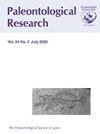Relationship between Modern Deep-Sea Ostracods and Water Mass Structure in East Antarctica
IF 0.6
4区 地球科学
Q3 PALEONTOLOGY
引用次数: 0
Abstract
Abstract. This study investigated the relationship between the distribution of modern ostracod biofacies and environmental factors in Lützow–Holm Bay, off Cape Darnley, and off Totten Glacier in East Antarctica. We collected study samples from water depths of 219 to 987 m by the 61st Japanese Antarctic Research Expedition. Nineteen species belonging to 13 genera and 47 species belonging to 31 genera of ostracods were found in three samples from Lützow–Holm Bay and ten samples from off Totten Glacier, respectively. We found no ostracods in the samples off Cape Darnley. Q-mode cluster analysis reveals four ostracod biofacies (A to D). Antarctiloxoconcha frigida (Neale, 1967) and Australicythere polylyca (Müller, 1908) were common under the influence of cold water in the upper bathyal zone (biofacies A to C). The genus Krithe was the most abundant taxon in biofacies D with low dissolved oxygen and high-water temperature (0.38°C, 34.66, and 5.0 ml/L, respectively), indicating the presence of warm deep seawater, i.e., modified Circumpolar Deep Water. Thus, we have checked the relationships between the ostracod assemblages and the environmental parameters analyzed in Lützow–Holm Bay and off Totten Glacier, and so strengthened the previous ostracod and environmental data.南极东部现代深海介形虫与水体结构的关系
摘要本研究调查了南极洲东部达恩利角附近的吕措-霍尔姆湾和托滕冰川附近现代介形虫生物相的分布与环境因素之间的关系。我们由第61次日本南极考察队从219至987米的水深收集了研究样本。在吕措-霍尔姆湾的3个样本和托滕冰川附近的10个样本中分别发现了介形虫13属19种和31属47种。我们在达恩利角附近的样本中没有发现介形虫。Q型聚类分析揭示了四种介形虫生物相(A至D)。Antarctiloxoconcha frigida(Neale,1967)和Australicythere polylyca(Müller,1908)在上层深海带(生物相A至C)的冷水影响下很常见。Krithe属是生物相D中最丰富的分类单元,具有低溶解氧和高水温(分别为0.38°C、34.66和5.0 ml/L),表明存在温暖的深海,即改良的环极深水。因此,我们检查了Lützow–Holm湾和托滕冰川附近分析的介形虫组合与环境参数之间的关系,从而加强了以前的介形虫和环境数据。
本文章由计算机程序翻译,如有差异,请以英文原文为准。
求助全文
约1分钟内获得全文
求助全文
来源期刊

Paleontological Research
PALEONTOLOGY-
CiteScore
1.60
自引率
0.00%
发文量
47
审稿时长
>12 weeks
期刊介绍:
Paleonotological Research (PR) is a quarterly, peer-reviewed international journal, which focuses on original contributions primarily in the area of paleontology but also covering a wide range of allied sciences. It has been published since 1997 as a successor to the former journal Transactions and Proceedings of the Palaeontological Society of Japan. The emphasis of contributions will include global and local perspectives, and contents can cover all ages (Precambrian to the Quaternary, including the present time).
 求助内容:
求助内容: 应助结果提醒方式:
应助结果提醒方式:


